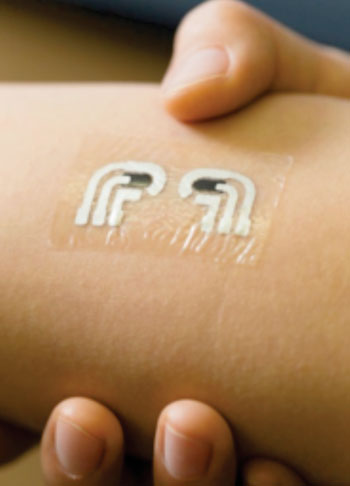Bioengineers Present Glucose Monitor Tattoo Prototype
By LabMedica International staff writers
Posted on 26 Jan 2015
A team of bioengineers has presented a prototype "proof-of-concept" version of a temporary tattoo that is able to extract and measure the level of glucose in the fluid between human skin cells.Posted on 26 Jan 2015
The flexible, easy to wear device consists of a pattern of electrodes printed on temporary tattoo paper that is attached to the skin. When a mild electrical current is applied to the skin for about 10 minutes, sodium ions and glucose molecules in the interstitial fluid migrate toward the tattoo's electrodes. A sensor built into the tattoo measures the strength of the electrical charge produced by the glucose to determine the patient's overall glucose level.

Image: Bioengineers have tested a flexible and easy to wear temporary tattoo that both extracts and measures the level of glucose in the fluid in between skin cells (Photo courtesy of the University of California, San Diego).
In a preliminary study, tattoos were applied to seven men and women between the ages of 20 and 40 with no history of diabetes. The volunteers were fed a carbohydrate-rich meal, and glucose levels were monitored by the tattoo and compared to those obtained by the traditional finger-stick method. Results showed that the tattoos detected the glucose spike following the meal with the same level of accuracy as the finger-stick.
"The concentration of glucose extracted by the noninvasive tattoo device is almost hundred times lower than the corresponding level in the human blood," said first author Amay Bandodkar, a graduate researcher at the University of California, San Diego (USA). "Thus we had to develop a highly sensitive glucose sensor that could detect such low levels of glucose with high selectivity. Eventually the instrument will also have Bluetooth readout capabilities to send this information directly to the patient's doctor in real-time or store data in the cloud. Presently the tattoo sensor can easily survive for a day. These are extremely inexpensive—a few cents—and hence can be replaced without much financial burden on the patient."
The paper describing the potential for glucose monitoring with a noninvasive flexible tattoo was published in the December 12, 2014, online edition of the journal Analytical Chemistry.
Related Links:
University of California, San Diego













